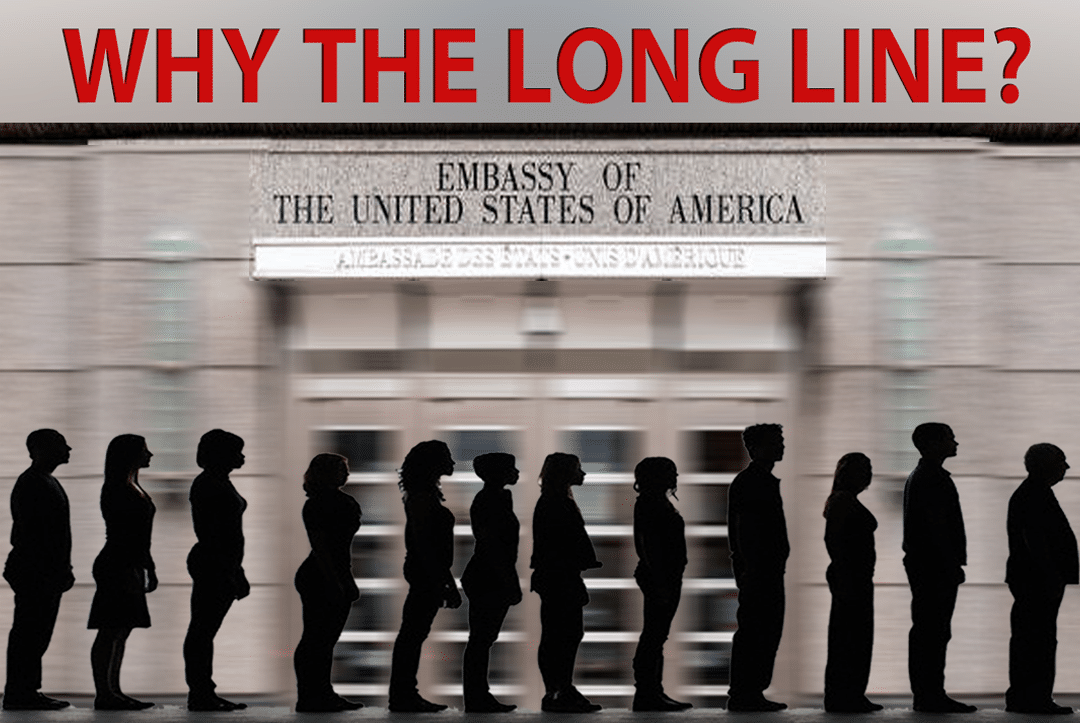To ensure that admitting huge numbers of new permanent residents will not overwhelm the economy of the United States, the U.S. government follows a strict visa allocation system. The U.S. Department of State reports the availability of immigrant numbers in its monthly report, the “Visa Bulletin.” Monitoring the Visa Bulletin is, therefore, useful if you are the recipient of an employment-based immigrant visa petition or have a family-based petition in the preference categories.
Under the Immigration and Nationality Act, the U.S. government may issue up to 675,000 immigrant visas each year. There are, however, more than that number of applicants every year. In fact, the Department of State or DOS, has over three million immigrant visa applicants in its database. This includes applicants within the U.S. waiting to adjust their status and applicants living outside the U.S. waiting for their interviews at a consular post. The DOS however, issues visas according to the visa categories and the date by which the U.S. Citizenship and Immigration Services, or USCIS, receives a specific visa petition.
Get an overview of the worldwide quotas and preference categories.
The Visa Bulletin and Visa Allocation
How available visa numbers are determined
The Visa Office (VO) computes the annual preference and foreign state limitations into monthly allotments. Several factors determine the numbers available for a specific allotment period, including:
- Past number use such as the number of applicants who qualified for a visa per category.
- Estimates of future number use and return rates. The State Department “returns” unused visa numbers in the following instances:
- Applicants cannot apply for their immigrant visa.
- An applicant is no longer eligible.
- If a petitioner has passed away, the principal applicant cannot apply or is not qualified for humanitarian reinstatement.
- Estimates of additional USCIS demand based on final action date movements.
After, the VO establishes the final action dates. Visa numbers are then allocated to reported applicants in order of their priority dates, with the oldest dates first. The NVC then announces the cut-off dates in the monthly Visa Bulletin.
Get an overview of reinstating a petition on humanitarian grounds.
The Consular Post and Reallocation of Visa Numbers
Each month, the Visa Office of the Department of State receives a report for each consular post for allocating visa numbers of categories subject to numerical limitations. Part of this report lists the number of documentarily qualified immigrant visa applicants. There are essential things to remember:
- Immediate Relatives are not subject to numerical limitations.
- There is a per-country yearly allocation of 25,620 for immigrant visa numbers.
- The DOS groups cases by country chargeability (or per country allocation), preference category, and priority date.
In certain instances, though, applicants in the U.S. get preference than those applying for visas at Embassies.
For example, the USCIS allocated almost 60,000 employment-preference numbers to those applying for adjustment of status in the U.S. The USCIS did this to reduce the backlog in July 2007. By reallocating visa numbers, the EB3 category suffered retrogression until the Visa Office made employment preference numbers available in October of that year.
Visa Categories and Visa Numbers
If there are enough visa numbers in any preference category for all reported documentarily qualified visa applicants, US government considers the category “current.” So, if the monthly allocation target is 3,000 and the DOS only reports 1,000 qualified applicants, the priority date cut-off is current.
Sometimes, the total documentarily qualified applicants in a category exceed the supply of numbers available for the particular month. When this situation happens, the category is “oversubscribed.”
The Visa Office determines the number of visas available so that the Final Action Date is established. The Final Action Date is the priority date of the first documentarily qualified applicant that the NVC could not issue a visa number.
Take this as an example. If the monthly target is 3,000 visa numbers, but there are 5,000 documentarily qualified visa applicants, the final action date cut-off that the Department of State will use would be the priority date of the 3,001st applicant.
Only persons with a priority date earlier than a final action date are entitled to a visa number.
Another factor to consider is the numerical limitation per country, which is set at 25,620. When visa demand from one country is more than that number, the DOS will consider that country to be oversubscribed. One example of an oversubscribed country is the Philippines.
How to Interpret the Visa Bulletin
The DOS, ensures that it issues visas in compliance with the visa allocation system on a worldwide and per country basis. Visa petitions are queued based on the date the USCIS filed and acknowledged them. The date of filing is the “priority date.”
The Visa Bulletin supports the visa allocation system. It has two charts showing the preference categories. The first chart is the “Date of Filing Chart.” It shows the priority dates ready for processing with the National Visa Center, a sub-agency of the DOS.
A second chart called the “Final Action Dates,” shows which petitions within the priority date cut-off are scheduled by the NVC for an interview at a consular post.
Date of Filing Chart
Take, for example, the Date of Filing Chart for the May 2020 Visa Bulletin.
| Family Preference Category | All Chargeability Areas Except Those Listed | China-mainland born | India | Mexico | Philippines |
|---|---|---|---|---|---|
| F1 | 22-Nov-14 | 22-Nov-14 | 22-Nov-14 | 08-Dec-99 | 01-Jun-11 |
| F2A | 01-Mar-20 | 01-Mar-20 | 01-Mar-20 | 01-Mar-20 | 01-Mar-20 |
| F2B | 22-SEP-15 | 22-Sep-15 | 22-Sep-15 | 08-Sep-99 | 01-Feb-11 |
| F3 | 15-DEC-08 | 15-Dec-08 | 15-Dec-08 | 15-Jul-00 | 22-Aug-01 |
| F4 | 28-Jul-07 | 28-Jul-07 | 08-Sep-05 | 22-Jan-99 | 01-Jun-01 |
In this May 2020 Date of Filing Chart, F1 immigrant visa applicants from the Philippines whose petitions were filed on or earlier than June 1, 2011, may already start processing their immigrant visa application with NVC.
Final Action Dates
The Visa Bulletin lists the May 2020 priority date cut-off dates scheduled for an interview at the U.S. Embassy in Manila in the Final Action Dates chart below. As you can see from the chart, the NVC or embassy should book you for an interview if your petitioner filed on or earlier than September 1, 2010.
The Visa Bulletin listed priority date cut-offs that it will schedule for interviews at the U.S. Embassy in the May 2020 Final Action Dates chart below.
| Family-Sponsored | All Chargeability Areas Except Those Listed | China-mainland born | India | Mexico | Philippines |
|---|---|---|---|---|---|
| F1 | 22-Mar-14 | 22-Mar-14 | 22-Mar-14 | 22-Oct-97 | 01-Sep-10 |
| F2A | Current | Current | Current | Current | Current |
| F2B | 15-Jan-15 | 15-Jan-15 | 15-Jan-15 | 15-Jan-99 | 01-Jun-10 |
| F3 | 15-Mar-08 | 15-Mar-08 | 15-Mar-08 | 08-Jun-96 | 15-Nov-00 |
| F4 | 22-Jul-06 | 22-Jul-06 | 08-Jan-05 | 15-Apr-98 | 01-Oct-00 |
Failure to take action on a visa application
Theoretically, it would be best if you waited for NVC to send you a letter by mail or email. So, it would be best if you kept the NVC informed of any change of address for you and your petitioner. The principal applicant is the person whose name is on the I-130 Approval Notice.
Even if your priority date is current, the NVC will not set an interview date for you until you have completed visa processing by:
- submitting all required documents to establish your continuing eligibility for the visa category.
- paying all the fees for the visa application.
Only then will the NVC consider you to be documentarily qualified as a visa applicant.
You should monitor how your priority date does in the monthly Visa Bulletin. Once the NVC informs you that an immigrant visa is available for your case, you must act on your application within one year. If you do not, the DOS may end your visa application and return your case to the USCIS.
Get information on how to petition a family member to live in the U.S.
Case Study for Using the US Visa Bulletin
Both Tom and Jerry are F1 applicants from the Philippines. Tom’s date of filing is May 31, 2011. Jerry’s petitioner filed his a day later, on June 1, 2011.
The date of filing chart shows that both Tom and Jerry should started processing their visa applications at the NVC. However, Jerry has been monitoring the U.S. Visa Bulletin and started contact with NVC. Tom was checking the Final Action Date chart.
Based on the May 2020 Visa Bulletin, F1 petitions from the Philippines filed on or earlier than September 1, 2010 are being scheduled by the NVC or embassy for an interview. Because Tom knows his priority date is May 31, 2011, he erroneously believed that he does not have to take action.
After six months, Jerry has an interview date. Tom just realized that he should start processing his immigrant visa at NVC. He had lost anywhere from 5 to 6 months. As long as Jerry passes the interview and physical/medical exam, the embassy will issue Jerry his immigrant visa ahead of Tom.
What happened? The NVC forwarded Jerry’s case to the U.S. Embassy in Manila for visa allocation for his category. Tom, however, did not complete visa processing with the NVC and remained in line while others passed him by.
Monitoring the Visa Bulletins for the second half of 2020
Like you, we’ll be monitoring the Visa Bulletins for the remainder of 2020 while serving up a short analysis per month on the movement of visa numbers. Stay tuned to this page!







